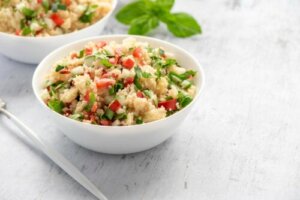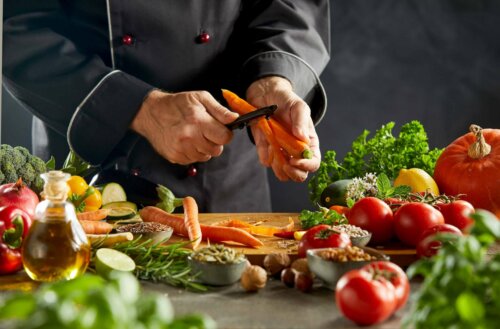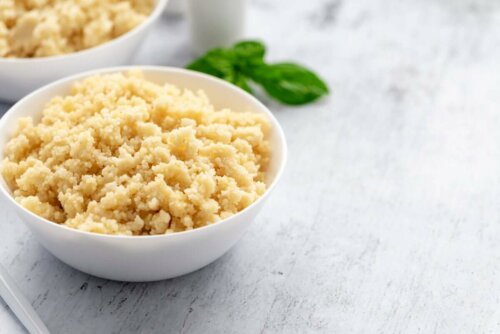An Easy Recipe for Vegetable Couscous


Written and verified by the nutritionist Saúl Sánchez Arias
Vegetable couscous should be part of any diet, in fact, it should be one of its staples. This is because these ingredients can provide essential nutrients for optimal body functioning. Not everyone likes veggies but today’s recipe will surely delight even the pickiest of eaters.
Firstly, a healthy diet is a well-balanced one so you must ensure there’s variety. In this respect, it’s important to mix and match ingredients to have a range of nutrients that’s as wholesome as possible.
Vegetable couscous
Before going into the recipe, we’d like to tell you about some of its nutritional properties. First of all, vegetables can reduce the risk of long-term cardiovascular problems according to a study published in the International Journal of Epidemiology.
Then there’s the protein element: tuna. This fish doesn’t only have high-quality proteins but also unsaturated fatty acids, omega-3. These nutrients can apparently reduce inflammation and thus, the incidence of many metabolic diseases.
Finally, let’s highlight the content of vitamin C in peppers. This micronutrient can increase endogenous collagen synthesis, modulate oxidation and boost immune function. According to a study published in Nutrients, their consumption reduces the duration of respiratory infectious conditions.

Check out these Four Recipes with Nuts that You Have to Try
Ingredients
- 1 c. of couscous
- 2 medium carrots
- 1 medium onion
- A medium crushed tomato
- 1 can of tuna
- Olive oil
- 2 bell peppers (red and green)
- Garlic
- Curry and any other spices you might want to add
Step by step
- The first thing you must do here is to boil the couscous. It’s actually quite simple, just boil some water in a pot and add it to it.
- Add a pinch of salt when the water begins to boil, mix it, and pour it over the couscous so as to cover it. Let it sit for about three to four minutes.
- Then, make a vegetable stir-fry. Begin by peeling and cutting the garlic into thin slices and brown it in a pan with extra virgin olive oil in the bottom. Then cut the rest of the vegetables into small pieces and incorporate them into the frying pan. Add the onion and a little salt and saute until translucent.
- You must cook the onion over medium heat until it’s soft, with a pinch of salt. Then, add the raw crushed tomato. This is the time to season it al – curry is a great spice for this dish, and so is oregano.
- Add the tuna once you’ve fried the vegetables for about seven minutes over medium-low heat. Then, turn it off and let it sit a few minutes so all flavors integrate. Finally, add the couscous and stir it.
Find out what are The Top Ten Ingredients That Make a Mediterranean Diet
There are many ways to eat vegetables without couscous
You were set on this recipe but just realized you have no couscous. No problem, you can always substitute it with other grains such as rice or quinoa as the main sources of carbohydrates.
The latter is actually great as it has a high fiber content.
Keep in mind that couscous is a highly processed grain and so its absorption at the intestinal level happens fast and can cause a sudden increase in blood glucose levels. There are better options even though its combination with vegetables can improve this process.

Vegetable couscous is a healthy dish
As you can see, vegetable couscous isn’t only a simple dish to make but also highly nutritious. You can cook it at night and keep it in the fridge until the next day at noon; it helps if you don’t have a lot of time to make food. In addition, you’ll be ensuring an optimal supply of nutrients and antioxidants.
Keep in mind that it’s essential to complement a proper diet with regular physical activity. The body will lose functionality otherwise. In addition, it’s also important to pay special attention to ensuring a good night’s rest.
All cited sources were thoroughly reviewed by our team to ensure their quality, reliability, currency, and validity. The bibliography of this article was considered reliable and of academic or scientific accuracy.
- Aune D, Giovannucci E, Boffetta P, Fadnes LT, Keum N, Norat T, Greenwood DC, Riboli E, Vatten LJ, Tonstad S. Fruit and vegetable intake and the risk of cardiovascular disease, total cancer and all-cause mortality-a systematic review and dose-response meta-analysis of prospective studies. Int J Epidemiol. 2017 Jun 1;46(3):1029-1056. doi: 10.1093/ije/dyw319. PMID: 28338764; PMCID: PMC5837313.
- Ishihara T, Yoshida M, Arita M. Omega-3 fatty acid-derived mediators that control inflammation and tissue homeostasis. Int Immunol. 2019 Aug 23;31(9):559-567. doi: 10.1093/intimm/dxz001. PMID: 30772915.
- Carr AC, Maggini S. Vitamin C and Immune Function. Nutrients. 2017 Nov 3;9(11):1211. doi: 10.3390/nu9111211. PMID: 29099763; PMCID: PMC5707683.
This text is provided for informational purposes only and does not replace consultation with a professional. If in doubt, consult your specialist.








